Fatigue Life Improvement of Weld Beads with Overlap Defects Using Ultrasonic Peening
Abstract
:1. Introduction
2. Materials and Methods
2.1. Materials
2.2. Test Procedures
3. Results
3.1. Surface Morphology of Overlap-Defect Weld
3.2. Microstructure
3.3. Microhardness
3.4. Tensile Properties
3.5. Fatigue Behavior
3.6. Residual Stress
4. Discussion
5. Conclusions
Author Contributions
Funding
Institutional Review Board Statement
Informed Consent Statement
Data Availability Statement
Conflicts of Interest
References
- Daivid, O.; Thomas, S.; Stephen, L.; Glen, E.; Scott, H.; Suzanne, H.; Theodore, Z.; Faith, R.; Laurie, H.; Nancy, S.; et al. Welding, Blazing, and Soldering. In ASM Handbook Volume 6; ASM International: Novelty, OH, USA, 1997; pp. 1073–1080. [Google Scholar]
- Liu, G.; Han, S.; Tang, X.; Cui, H. Effect of torch configuration on arc interaction behaviors and weld defect formation mechanism in tandem pulsed GMAW. J. Manuf. Process. 2022, 62, 729–742. [Google Scholar] [CrossRef]
- Stefania, P.; Fanny, S.; Fabio, F.; Pasquale, C. Welding defects classification through a Convolutional Neural Network. Manuf. Lett. 2023, 35, 29–32. [Google Scholar] [CrossRef]
- Liu, X.; Guo, Z.; Bai, D.; Yuan, C. Study on the mechanical properties and defect detection of low alloy steel weldments for large cruise ships. Ocean Eng. 2022, 258, 111815. [Google Scholar] [CrossRef]
- Wang, D.Q.Q.; Yao, D.D.; Gao, Z.B.; Wang, Q.; Zhang, Z.F.; Li, X.W. Fatigue mechanism of medium-carbon steel welded joint: Competitive impacts of various defects. Int. J. Fatigue 2021, 151, 106363. [Google Scholar] [CrossRef]
- Xu, H.; Yan, Z.H.; Ji, B.W.; Huang, P.F.; Cheng, J.P.; Wu, X.D. Defect detection in welding radiographic images based on semantic segmentation methods. Measurement 2022, 188, 110569. [Google Scholar] [CrossRef]
- Li, S.; Dong, H.; Wang, X.; Liu, Z.; Tan, Z.; Shangguan, L.; Lu, Q.; Zhong, S. Effect of repair welding on microstructure and mechanical properties of 7N01 aluminum alloy MIG weld joint. J. Manuf. Process. 2020, 54, 80–88. [Google Scholar] [CrossRef]
- Gao, Z.; Gong, B.; Liu, Y.; Wang, D.; Deng, C.; Hu, D. Fatigue-performance of PWHT welded joints: As-welded vs. high-frequency mechanical impact treatment. J. Constr. Steel Res. 2021, 187, 106933. [Google Scholar] [CrossRef]
- Massoud, M.; Hongtao, D. A review of ultrasonic peening treatment. Mater. Des. 2015, 87, 1072–1086. [Google Scholar] [CrossRef]
- Zhu, L.; Guan, Y.; Zheng, H.; Wang, Z.; Lin, J.; Yu, W.; Zhai, J.; Xie, Z. A new analytical model to predict residual stress induced by ultrasonic shot peening. Int. J. Mech. Sci. 2022, 227, 107430. [Google Scholar] [CrossRef]
- Zhou, J.; Sun, Z. Numerical characterization of shot peening induced work hardening gradient and verification based on FEM analysis. Int. J. Solids Struct. 2022, 244–245, 111586. [Google Scholar] [CrossRef]
- Yan, H.; Zhu, P.; Chen, Z.; Zhang, H.; Zhang, Y.; Zhang, Y. Effect of shot peening on the surface properties and wear behavior of heavy-duty-axle gear steels. J. Mater. Res. Technol. 2022, 17, 22–32. [Google Scholar] [CrossRef]
- Zhang, H.-X.; Luo, Y.; Zang, J.-Y.; Jiang, W.-C. Comparison of strengthening effect and fatigue properties of SAF2205 cruciform welded joints by ultrasonic impact and cavitation jet peening treatment. Mater. Sci. Eng. A 2022, 852, 143717. [Google Scholar] [CrossRef]
- Feng, X.; Pan, X.; He, W.; Liu, P.; An, Z.; Zhou, L. Improving high cycle fatigue performance of gas tungsten arc welded Ti6Al4V titanium alloy by warm laser shock peening. Int. J. Fatigue 2021, 149, 106270. [Google Scholar] [CrossRef]
- Li, X.; Ma, R.; Liu, X.; Lv, Q.; Wang, X.; Tian, Z. Effect of laser shock peening on fatigue properties of U75VG rail flash-butt welding joints. Opt. Laser Technol. 2022, 149, 107889. [Google Scholar] [CrossRef]
- Tian, Y.; Shen, J.; Hu, S.; Liang, Y.; Bai, P. Effects of ultrasonic peening treatment on surface quality of CMT-welds of Al alloys. J. Mater. Process. Technol. 2018, 254, 193–200. [Google Scholar] [CrossRef]
- Wan, Z.; Dai, W.; Guo, W.; Jia, Q.; Zhang, H.; Xue, J.; Lin, L.; Peng, P. Improved corrosion resistance of Ni-base alloy 600 welded joint by laser shock peening. J. Manuf. Process. 2022, 80, 718–728. [Google Scholar] [CrossRef]
- Lu, X.; Qian, F.; Sun, Z.; Shi, L.; Li, W.; Zhao, C.; Cao, D. Ultrasonic peening for dieless metal deformation in vacuum conditions. Sens. Actuators A Phys. 2022, 342, 113628. [Google Scholar] [CrossRef]
- Talaş, Ş. The assessment of carbon equivalent formulas in predicting the properties of steel weld metals. Mater. Des. 2010, 31, 2649–2653. [Google Scholar] [CrossRef]
- Kuryntsev, S.V. Microstructure, mechanical and electrical properties of laser-welded overlap joint of CP Ti and AA2024. Opt. Lasers Eng. 2019, 112, 77–86. [Google Scholar] [CrossRef]
- Miao, R.; Shan, Z.; Zhou, Q.; Wu, Y.; Ge, L.; Zhang, J.; Hu, H. Real-time defect identification of narrow overlap welds and application based on convolutional neural networks. J. Manuf. Syst. 2022, 62, 800–810. [Google Scholar] [CrossRef]
- Wang, Z.; Teng, J.; Wang, D.; Cui, L.; Liu, H.; Yang, J.; Zhang, Y.; Zhu, H. Observations of repair process by friction stitch welding in simulated wet conditions—Flaws, microstructure and hardness evolutions in overlapping welds. J. Mater. Process. Technol. 2019, 264, 220–233. [Google Scholar] [CrossRef]
- Muhayat, N.; Matien, Y.A.; Sukanto, H.; Saputro, Y.C.N.; Triyono. Fatigue life of underwater wet welded low carbon steel SS400. Heliyon 2020, 6, e03366. [Google Scholar] [CrossRef] [PubMed]
- Mohamat, S.A.; Ibrahim, I.A.; Amir, A.; Ghalib, A. The effect of flux core arc welding (FCAW) processes on different parameters. Procedia Eng. 2012, 41, 1497–1501. [Google Scholar] [CrossRef] [Green Version]
- Zhao, G.; Chen, S.; Wu, L.; Wen, Z.; Wang, H. Study of constitutive relation of rail decarburized layer. Eng. Fail. Anal. 2021, 130, 105792. [Google Scholar] [CrossRef]
- Zhao, H.; Gao, J.; Qi, J.; Tian, Z.; Chen, H.; Zhang, H.; Wang, C. Modelling and simulation of isothermal and continuous-heating surface decarburization behaviour of Fe-0.6C-1.8Si-0.8Mn spring steel. J. Mater. Res. Technol. 2021, 15, 1076–1089. [Google Scholar] [CrossRef]
- Pepelnjak, T.; Barisic, B. Analysis and elimination of the stretcher strains on TH415 tinplate rings in the stamping process. J. Mater. Process. Technol. 2007, 186, 111–119. [Google Scholar] [CrossRef]
- Wang, X.; Xu, C.; Hu, D.; Li, C.; Liu, C.; Tang, Z. Effect of ultrasonic shot peening on surface integrity and fatigue performance of single-crystal superalloy. J. Mater. Process. Technol. 2021, 296, 117209. [Google Scholar] [CrossRef]
- Li, Y.; Shang, X.; Zhai, M.; Yu, L.; Wang, L.; Zhao, S. Surface characteristics and microstructure evolution of a nickel-base single crystal superalloy treated by ultrasonic shot peening. J. Alloy. Compd. 2022, 919, 165761. [Google Scholar] [CrossRef]
- Yang, B.; Tan, C.; Zhao, Y.; Wu, L.; Chen, B.; Song, X.; Zhao, H.; Feng, J. Influence of ultrasonic peening on microstructure and surface performance of laser-arc hybrid welded 5A06 aluminum alloy joint. J. Mater. Res. Technol. 2020, 9, 9576–9587. [Google Scholar] [CrossRef]
- Wang, Z.D.; Sun, G.F.; Lu, Y.; Chen, M.Z.; Bi, K.D.; Ni, Z.H. Microstructural characterization and mechanical behavior of ultrasonic impact peened and laser shock peened AISI 316L stainless steel. Surf. Coat. Technol. 2020, 385, 125403. [Google Scholar] [CrossRef]
- Chen, H.; Guan, Y.; Zhu, L.; Li, Y.; Zhai, J.; Lin, J. Effects of ultrasonic shot peening process parameters on nanocrystalline and mechanical properties of pure copper surface. Mater. Chem. Phys. 2021, 259, 124025. [Google Scholar] [CrossRef]
- Agostini, P.; Coppola, R.; Hofmann, M.; Ohms, C.; Tucek, K. Stress distribution in a 316L(N) steel narrow gap TIG model weld for Gen IV nuclear applications. Nucl. Mater. Energy 2022, 32, 101203. [Google Scholar] [CrossRef]
- Li, X.; Hu, L.; Deng, D. Influence of contact behavior on welding distortion and residual stress in a thin-plate butt-welded joint performed by partial-length welding. Thin-Walled Struct. 2022, 176, 109302. [Google Scholar] [CrossRef]
- Leguinagoicoa, N.; Albizuri, J.; Larrañaga, A. Fatigue improvement and residual stress relaxation of shot-peened alloy steel DIN 34CrNiMo6 under axial loading. Int. J. Fatigue 2022, 162, 107006. [Google Scholar] [CrossRef]
- Gao, Z.; Han, B.; Li, L.; Ma, G.; Niu, S. Numerical simulation of residual stress in post internal-welding process of bimetal composite pipe and optimization of welding sequence. Int. J. Press. Vessel. Pip. 2022, 199, 104730. [Google Scholar] [CrossRef]
- Wang, L.; Qian, X. Welding residual stresses and their relaxation under cyclic loading in welded S550 steel plates. Int. J. Fatigue 2022, 162, 106992. [Google Scholar] [CrossRef]
- Sasahara, H. The effect on fatigue life of residual stress and surface hardness resulting from different cutting conditions of 0.45%C steel. Int. J. Mach. Tools Manuf. 2005, 45, 131–136. [Google Scholar] [CrossRef]


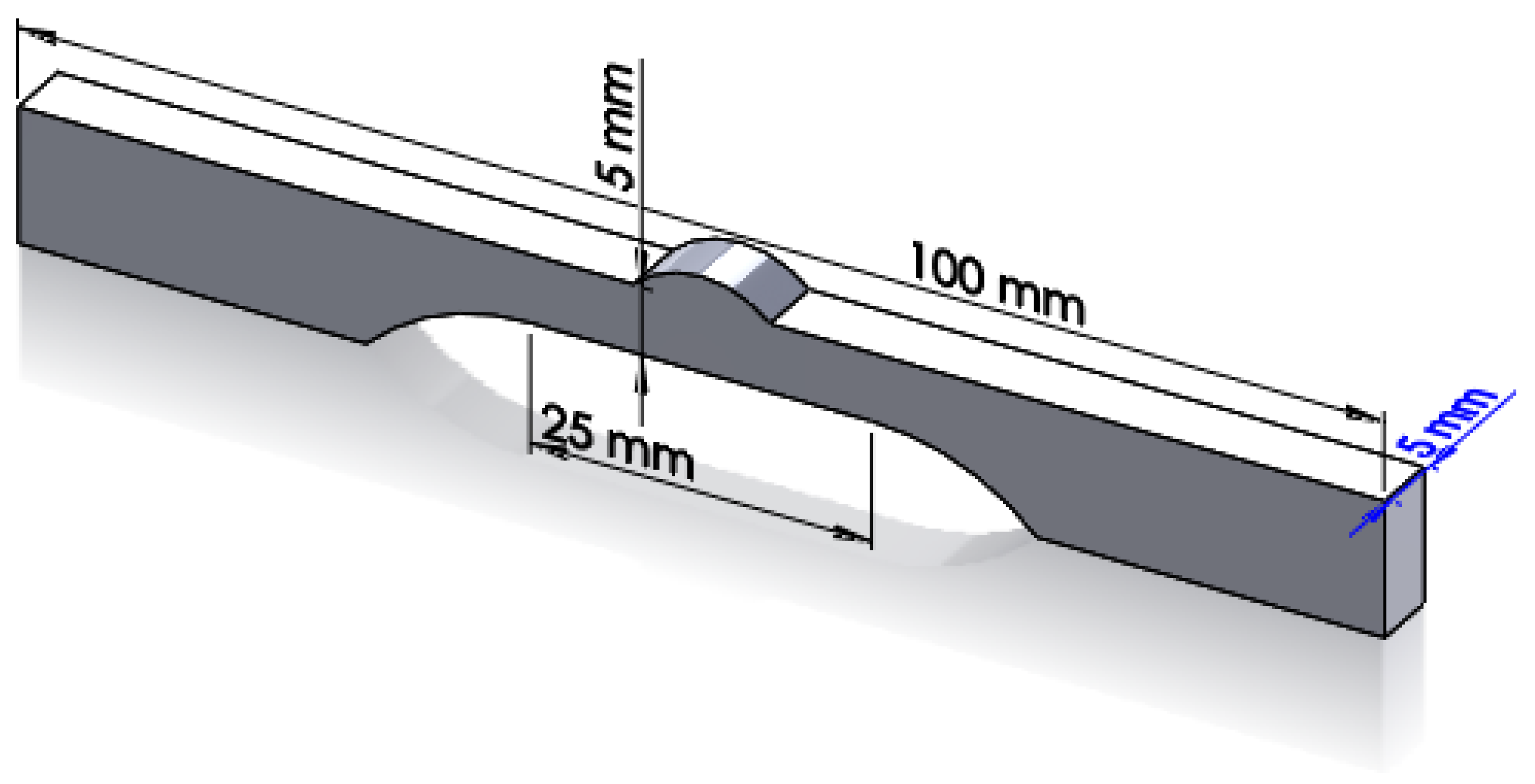

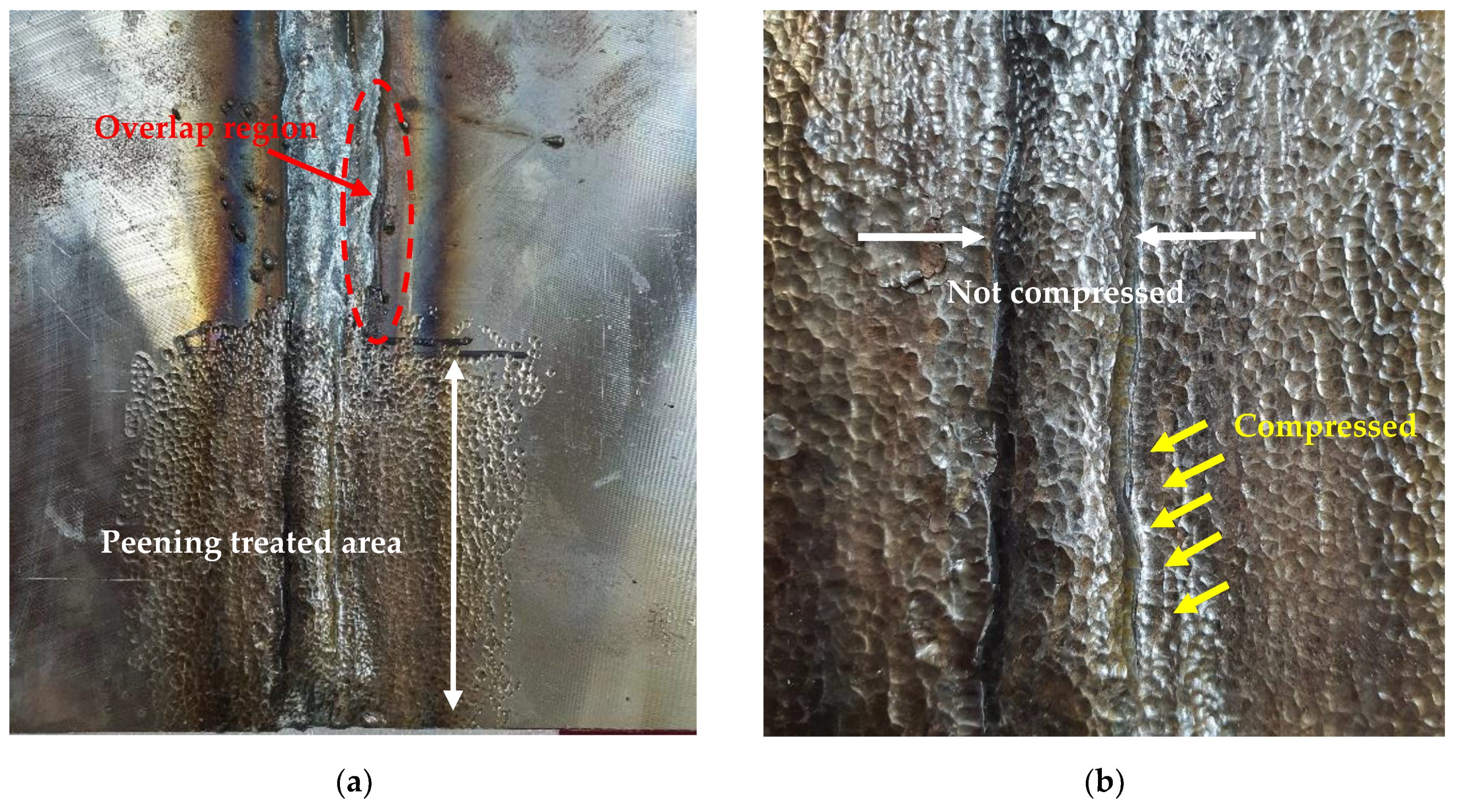



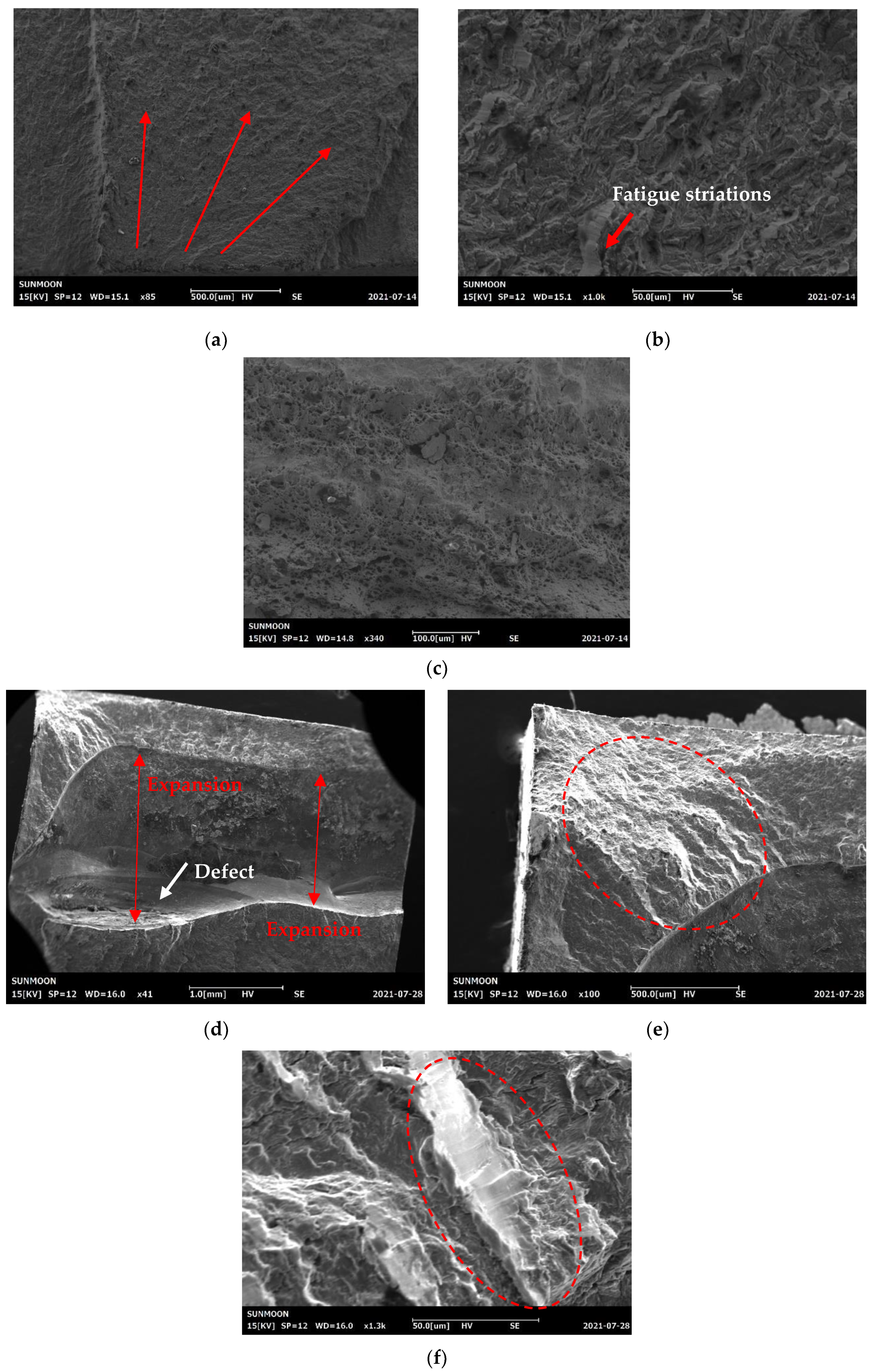
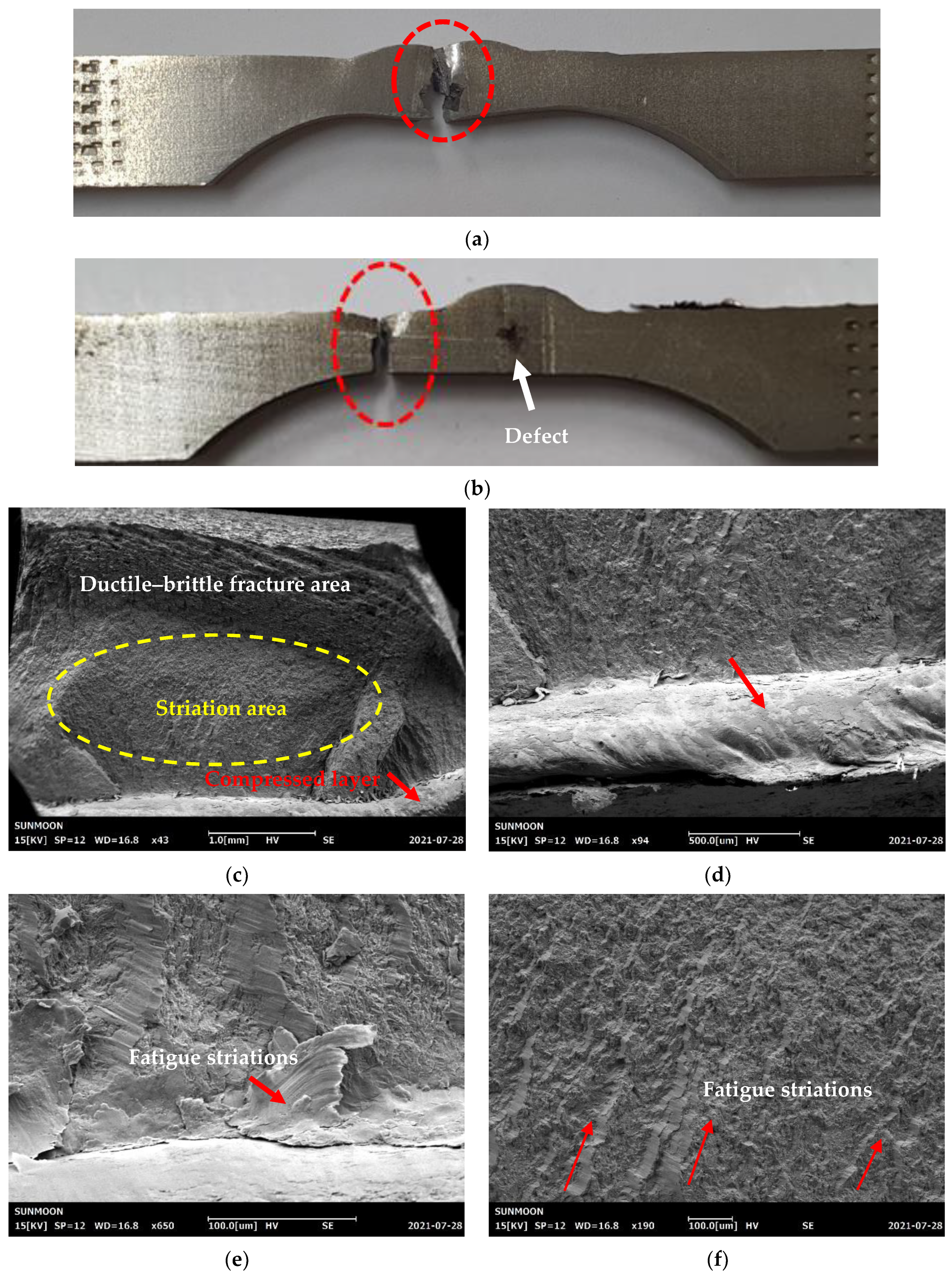




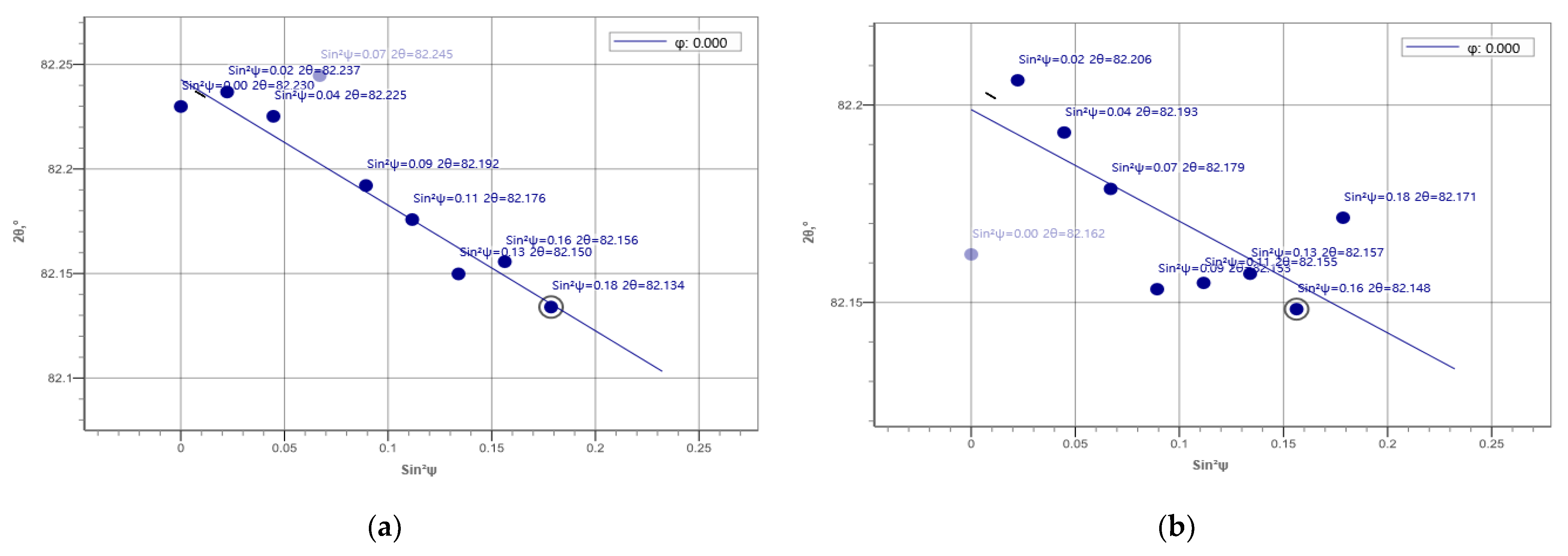

| Depth from Surface (mm) | Hardness before Peening (HV) | Hardness after Peening (HV) | ||||
|---|---|---|---|---|---|---|
| HAZ(L) | Bead | HAZ(R) | HAZ(L) | Bead | HAZ(R) | |
| 0.2 | 124.4 | 158.2 | 135.2 | 170.5 | 189.3 | 172.3 |
| 0.5 | 122.3 | 152.5 | 128.4 | 168.7 | 197.2 | 170.2 |
| 0.8 | 125.4 | 160.3 | 122.5 | 169.2 | 185.2 | 168.8 |
| 1.0 | 121.0 | 165.7 | 122.9 | 157.3 | 172.6 | 158.5 |
| 1.3 | 123.2 | 163.0 | 123.6 | 145.2 | 169.5 | 143.8 |
| 1.7 | 124.6 | 163.6 | 126.3 | 137.5 | 161.2 | 135.2 |
| 2.0 | 122.5 | 161.2 | 124.8 | 128.7 | 162.5 | 130.5 |
| 2.3 | 125.1 | 160.9 | 125.9 | 122.5 | 160.8 | 125.7 |
| 2.7 | 122.4 | 162.5 | 123.7 | 121.3 | 161.3 | 122.8 |
| 3.0 | 125.7 | 161.5 | 123.2 | 122.9 | 161.5 | 122.5 |
| Average | 123.7 | 160.9 | 126.6 | 144.4 | 172.1 | 145.0 |
| Property | Normal Specimen | Overlap-Defect Specimen | Peened Overlap-Defect Specimen |
|---|---|---|---|
| Yield strength (MPa) | 277 | 231 | 289 |
| Tensile strength (MPa) | 399 | 345 | 434 |
| Elongation (%) | 26.5 | 17.8 | 22.1 |
| Test Number | Normal Specimen | Overlap-Defect Specimen | Peened Overlap-Defect Specimen |
|---|---|---|---|
| 1st | 108,508 | 2543 | 121,012 |
| 2nd | 118,210 | 2266 | 118,513 |
| 3rd | 111,102 | 2439 | 119,322 |
| 4th | 107,589 | 2355 | 120,583 |
| 5th | 113,218 | 2512 | 115,420 |
| Average | 111,725 | 2423 | 118,970 |
| Specimen | Location | ||
|---|---|---|---|
| Heat-Affected Zone | Upper Region of the Bead | Middle Region of the Bead | |
| Overlap-defect specimen | −386 MPa | 1496 MPa | 1037 MPa |
| Peened overlap-defect specimen | 978 MPa | 460 MPa | 647 MPa |
Disclaimer/Publisher’s Note: The statements, opinions and data contained in all publications are solely those of the individual author(s) and contributor(s) and not of MDPI and/or the editor(s). MDPI and/or the editor(s) disclaim responsibility for any injury to people or property resulting from any ideas, methods, instructions or products referred to in the content. |
© 2023 by the authors. Licensee MDPI, Basel, Switzerland. This article is an open access article distributed under the terms and conditions of the Creative Commons Attribution (CC BY) license (https://creativecommons.org/licenses/by/4.0/).
Share and Cite
Song, S.-H.; Lee, C.-S.; Lim, T.-H.; Amanov, A.; Cho, I.-S. Fatigue Life Improvement of Weld Beads with Overlap Defects Using Ultrasonic Peening. Materials 2023, 16, 463. https://doi.org/10.3390/ma16010463
Song S-H, Lee C-S, Lim T-H, Amanov A, Cho I-S. Fatigue Life Improvement of Weld Beads with Overlap Defects Using Ultrasonic Peening. Materials. 2023; 16(1):463. https://doi.org/10.3390/ma16010463
Chicago/Turabian StyleSong, Seung-Hyon, Chang-Soon Lee, Tae-Hwan Lim, Auezhan Amanov, and In-Sik Cho. 2023. "Fatigue Life Improvement of Weld Beads with Overlap Defects Using Ultrasonic Peening" Materials 16, no. 1: 463. https://doi.org/10.3390/ma16010463





